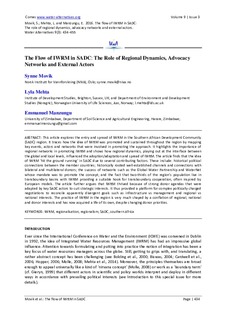| dc.contributor.author | Movik, Synne | |
| dc.contributor.author | Mehta, Lyla | |
| dc.contributor.author | Manzungu, Emmanuel | |
| dc.date.accessioned | 2018-07-12T11:52:09Z | |
| dc.date.available | 2018-07-12T11:52:09Z | |
| dc.date.created | 2016-11-28T11:26:42Z | |
| dc.date.issued | 2016 | |
| dc.identifier.citation | Water Alternatives - An interdisciplinary journal on water, politics and development. 2016, 9 (3), 434-455. | nb_NO |
| dc.identifier.issn | 1965-0175 | |
| dc.identifier.uri | http://hdl.handle.net/11250/2505255 | |
| dc.description.abstract | This article explores the entry and spread of IWRM in the Southern African Development Community (SADC) region. It traces how the idea of IWRM was pro moted and sustained throughout the region by mapping key events, actors and networks that were involved in promoting the approach. It highlights the importance of regional networks in promoting IWRM and shows how regional dynamics, playing out at the inter face between the global and local levels, influenced the adoption/adaptation and spread of IWRM. The article finds that the idea of IWRM 'hit the ground running' in SADC due to several contributing factors. These include: historical political connections between the member countries; historically rooted well established channels and connections with bilateral and multilateral donors; the success of networks such as the Global Water Partnership and WaterNet whose mandate was to promote the concept; and the fact that two-thirds of the region’s population live in transboundary basins with IWRM providing a suitable hook for transboundary cooperation, often inspired by European models. The article further argues that IWRM thrived because of strong donor agendas that were adapted by key SADC actors to suit strategic interests. It thus provided a platform for complex politically charged negotiations to reconcile apparently divergent goals such as infrastructure vs management and regional vs national interests. The practice of IWRM in the region is very much shaped by a conflation of regional, national and donor interests and has now acquired a life of its own, despite changing donor priorities. | nb_NO |
| dc.description.abstract | The Flow of IWRM in SADC: The Role of Regional Dynamics, Advocacy Networks and External Actors | nb_NO |
| dc.language.iso | eng | nb_NO |
| dc.relation.uri | http://www.water-alternatives.org/index.php/alldoc/articles/vol9/v9issue3/335-a9-3-3/file | |
| dc.rights | Attribution-NonCommercial-NoDerivatives 4.0 Internasjonal | * |
| dc.rights.uri | http://creativecommons.org/licenses/by-nc-nd/4.0/deed.no | * |
| dc.title | The Flow of IWRM in SADC: The Role of Regional Dynamics, Advocacy Networks and External Actors | nb_NO |
| dc.title.alternative | The Flow of IWRM in SADC: The Role of Regional Dynamics, Advocacy Networks and External Actors | nb_NO |
| dc.type | Journal article | nb_NO |
| dc.type | Peer reviewed | nb_NO |
| dc.description.version | publishedVersion | nb_NO |
| dc.source.pagenumber | 434-455 | nb_NO |
| dc.source.volume | 9 | nb_NO |
| dc.source.journal | Water Alternatives - An interdisciplinary journal on water, politics and development | nb_NO |
| dc.source.issue | 3 | nb_NO |
| dc.identifier.cristin | 1404954 | |
| cristin.unitcode | 192,13,1,0 | |
| cristin.unitname | Institutt for internasjonale miljø- og utviklingsstudier | |
| cristin.ispublished | true | |
| cristin.fulltext | original | |
| cristin.qualitycode | 1 | |

